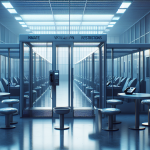Special Alternative Incarceration Facility (SAI) – Overview and Information
A Special Alternative Incarceration facility, or SAI, is a correctional facility that provides incarceration and rehabilitation services for people who have been charged with a crime. The facility works to ensure offenders can stay in the community and continue employment opportunities while decreasing criminal behavior and re-entering the criminal justice system.
The SAI program is designed to reduce the number of individuals sent to state correctional institutions through the use of alternative sentencing strategies, such as diversion and probation. These facilities provide basic needs, such as education, job training, substance-abuse counseling, and other services necessary for successful reintegration into the community.
SAI programs may include level one minimum security facilities, “bunking” in the field, indoor residential correctional centers, and community work centers. The structure enables participants to live on-site, work in the community, and attend treatment and educational classes. Integrated treatment approaches are used to create and maintain a secure and rehabilitative environment.
To be admitted into a SAI program, offenders must meet certain criteria. Individuals must be nonviolent and have no prior experience with the criminal justice system. SAI programs are also offered to persons who have committed major crimes, such as drug possession, and are considered to be more of a risk.
SAI programs have proven to be successful in lowering not only recidivism rates, but also the amount of money used to fund the corrections system. This form of alternative sentencing has enabled individuals to receive the necessary support to become productive members of society without having to spend time in a traditional prison setting.
Through the SAI program, participants can successfully remain in the community without burdening their families, friends, and taxpayers. Being able to stay in the community also helps offenders develop more positive relationships with family and friends, which can reduce the risk of further criminal behavior.
Special Alternative Incarceration Facility (SAI) – Classes, Services, and Programs
A Special Alternative Incarceration Facility (SAI) is an alternative to the traditional prison system. It is designed to provide an effective, cost-efficient, and humane re-entry program to reduce the recidivism rate. SAI programs focus on addressing an inmate’s underlying behavioral, social, and psychological issues, enabling them to develop patterns of behavior that are more conducive to living successfully in the community.
Classes: Most SAI facilities offer classes on a variety of topics, such as substance abuse, anger management, life skills, and job readiness skills. These classes typically involve group discussions, role-playing, and other interactive activities. The classes are designed to help inmates achieve self-sufficiency, motivation, and leadership with a focus on developing skills to help them transition back into society successfully.
Services: SAI facilities also provide various services to help inmates address their needs and successfully reintegrate into the community. These services may include individual and group counseling, educational programs, employment assistance, and even housing assistance. In addition, many SAI facilities also offer recreational activities to help inmates maintain mental and physical health.
Programs: Many SAI facilities offer specific programs for inmates with specific needs. For example, an inmate with mental health issues may be enrolled in a program that focuses on helping them manage their symptoms. There may also be programs designed to help inmates develop useful life and job skills or programs to help inmates transition to independent living.
The goal of SAI programs is to provide inmates with the tools they need to be successful citizens. These programs offer the opportunity for inmates to take responsibility for their own rehabilitation and promote positive behaviors in a safe and secure environment. By providing inmates with equitable access to beneficial services and rehabilitation, SAI facilities help reduce the recidivism rate and ensure that inmates are being given a second chance at a productive life.
Inmate visiting application in Special Alternative Incarceration Facility (SAI)
Special Alternative Incarceration Facility (SAI) is a form of correctional facility where offenders serve out their sentences instead of being detained in a more traditional institution. It is designed to help detainees lead more positive and productive lives while still being held accountable to their sentence.
When visiting an inmate in an Special Alternative Incarceration Facility (SAI) visiting application form must be filled out. This form requires necessary information about the inmate as well as the visitor. It is important to provide accurate information on this form as it is used to approve or deny a visitation request.
To start, the visitor must provide their full name and contact information. The site will also ask for government-issued identification. Additionally, the form will ask series of questions about the visitor’s relationship with the inmate, as well as whether the visitor has any outstanding warrants. It is important to answer these questions accurately and honestly as false statements could result in the rejection of the visitation request.
If the application is approved, the visitor can then choose when to arrive for visitation hours at the SAI. Upon arrival, the visitor must present a valid photo ID and pass through security. Inside the facility, visitors are expected to adhere to dress code and rules set forth by the facility. Commonly restricted items include cigarettes, alcohol, money, pictures, and any type of weapon.
Visitation is monitored by SAI staff. Visitors are expected to remain respectful of the facility and its inmates, not bring contraband, and follow all instructions from the staff. It is important to remember that visitors are not allowed to bring any items for the inmate, nor can they hug or kiss the inmate during the visitation.
In summary, before visiting an inmate in an Special Alternative Incarceration Facility (SAI), all visitors must fill out a visitation application and pass the security screening. It is important to be respectful of the staff and the facility and abide by all rules in order to ensure a successful visit.
Special Alternative Incarceration Facility (SAI): Frequently Asked Questions and Answers
Special Alternative Incarceration Facility (SAI) is a correctional system alternative to traditional incarceration for non-violent offenders. The goal of this system is to provide individuals with the appropriate resources and transitional assistance to succeed upon their release from incarceration. This article will answer some of the most frequently asked questions about the SAI system.
What is the Special Alternative Incarceration Facility (SAI)?
The Special Alternative Incarceration Facility (SAI) is a correctional system alternative to traditional incarceration for non-violent offenders. It is designed to provide rehabilitative and transitional assistance to offenders so that they may successfully re-enter the community after completing their sentences.
What types of offenders are eligible for SAI?
Most typically, non-violent offenders, those with a shorter sentence, or those who demonstrate a commitment to rehabilitation are eligible for SAI programs. Each situation is assessed individually to determine if the offender qualifies and meets all the requirements for participation in an SAI program.
What services are provided by the SAI?
Services offered through SAI are tailored to individual needs. These may include education, counseling, substance abuse treatment, skill development, and job training. SAI also provides support and resources for employers and community organizations working with offenders.
How does SAI differ from traditional incarceration?
In traditional incarceration, inmates are kept locked up in cells and monitored by corrections officers. In SAI, offenders interact with others in the reintegration process, given access to rehabilitative resources, and expected to motivate themselves. Additionally, inmates typically spend only a portion of their sentence in SAI, whereas traditional incarceration involves longer sentences.
Is SAI considered successful?
SAI is considered the most successful correctional system alternative to traditional incarceration. Studies have shown that even after 12 months, SAI participants demonstrate more positive outcomes than those who remain incarcerated, such as lower recidivism rates, improved employment, increased community engagement, and overall higher levels of self-sufficiency.
Is SAI available in all states?
SAI is available in most states, but availability may vary by state. Contact your local correctional department to find out if SAI programs are available in your area.






